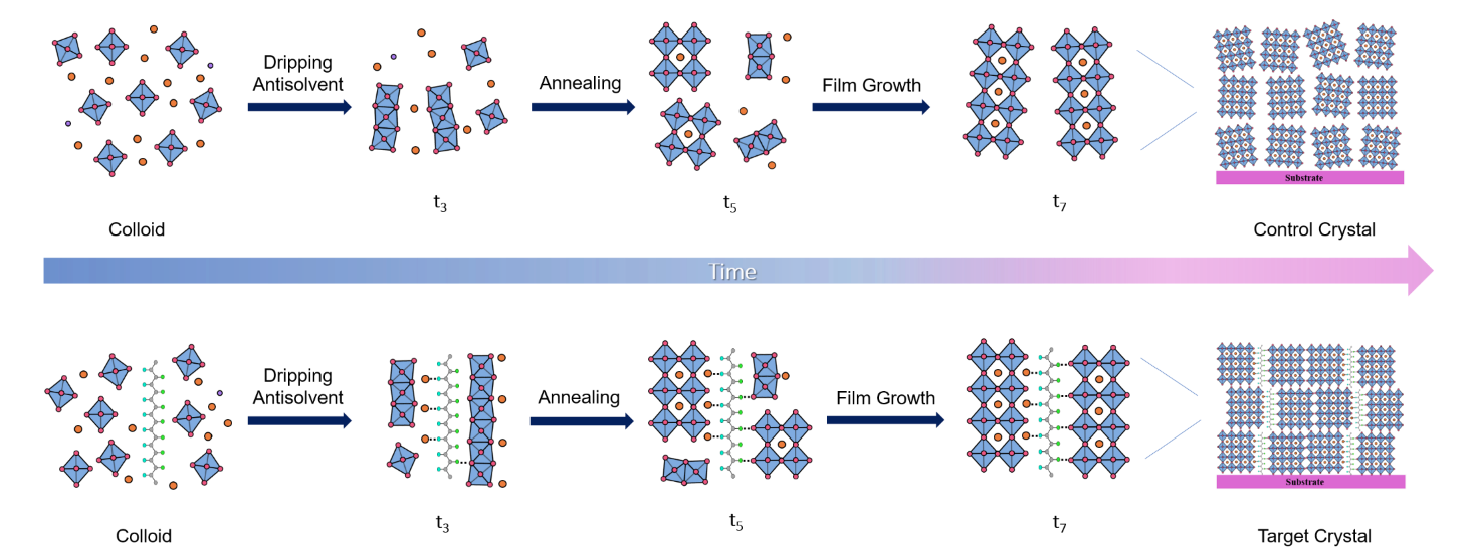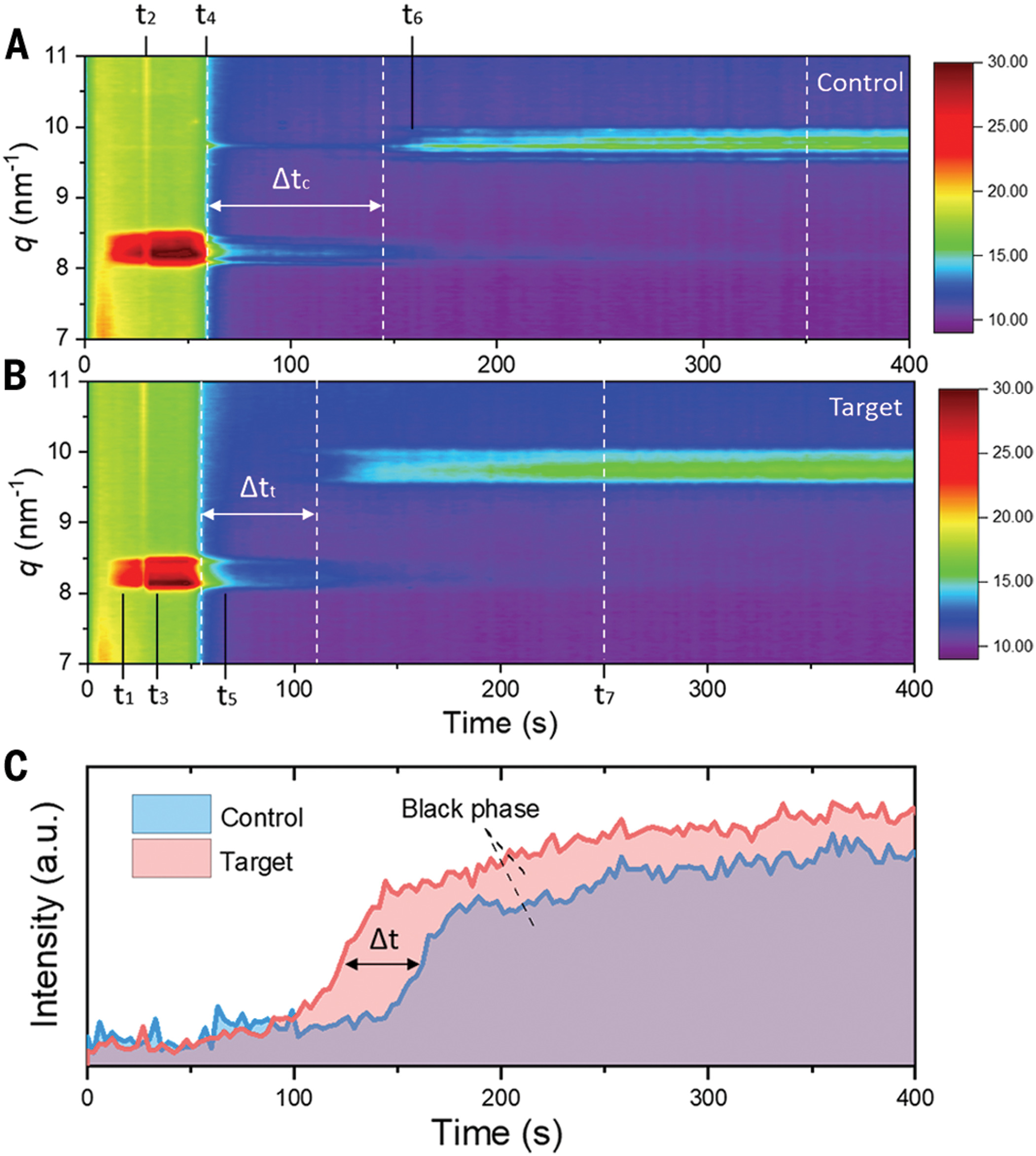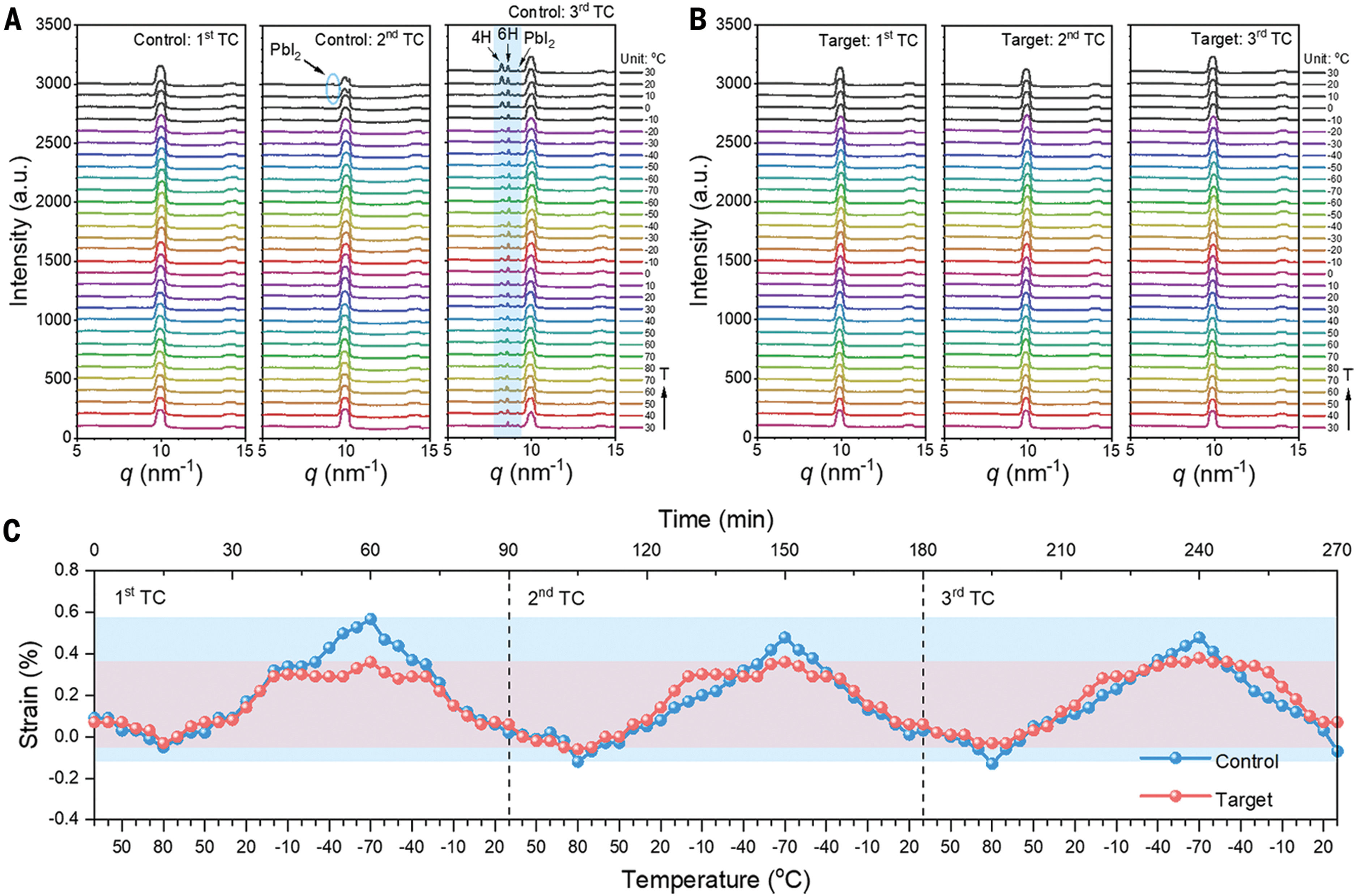Scientific Achievement
Li Meng of Henan University, together with Antonio Abate of the Helmholtz Centre for Materials and Energy in Germany, and other researchers observed the crystallisation dynamics of perovskite thin films and in-situ strain under hot and cold fatigue with the help of the in-situ glove box spin-coating device and in-situ temperature-variable device of the Shanghai Light Source Diffraction Line Station BL14B1, which provides an important basis for the stability of perovskite solar cells.
Significance and Impact
This breakthrough work reveals that β-PVDF can effectively improve the crystalline properties of perovskite thin films, effectively passivate the interfacial defects on the surface of thin film crystals, optimise the energy level arrangement of the perovskite interfaces, and promote the carrier transport, thus enhancing the photovoltaic properties of p-i-n-structured perovskite devices. What's more, the ordered arrangement of β-PVDF at grain boundaries can effectively buffer the deformation of grain boundaries caused by grain extrusion and release the lattice stresses during the temperature change process to achieve a restorable crystal structure, which significantly improves the stability of the device at variable temperatures. The research results will be published in Science in January 2023 under the title "Highly efficient p-i-n perovskite solar cells that endure temperature variations".

Fig. 1 | Crystallisation kinetics of perovskite solar cell films
Research background
Organometallic halide perovskite-based solar cells have received widespread attention due to their low material cost, ease of preparation of large-area devices, and high photovoltaic conversion efficiency. In the practical application environment with huge temperature difference between day and night, the temperature change will trigger the phase transition and lattice strain of perovskite materials, resulting in the rapid degradation of the device performance and damage, which is the key challenge and problem that restricts the perovskite solar cells to be applied.
Main research contents
The researchers performed synchrotron GIWAXS-based characterisation of the entire process of film formation. Comparing the GIWAXS patterns (Fig. 2 A and B), the weakening of the diffraction signal during the first 60 s indicates the suppression of the initial intermediate phase of DMSO-DMF-PbX2. This effect can be attributed to the isolation of the intermediate phase by the long-chain β-pV2F molecule. Scattering features centred at q = ~10 nm-1 along the (001) crystal plane observed during film formation indicate that the colloid has solidified and transformed into the black phase. β-pV2F facilitates the transformation of the intermediate phase into the calcite black phase. The rapid phase transition is associated with lower formation energies due to the rapid aggregation of dispersed PbX2 and organic salts by β-pV2F during the volatilisation of DMSO and DMF. When crystallisation was complete (stage t7), the signal of the target film was stronger than that of the control film (Fig. 2c). This result suggests that the formed target perovskite film is more ordered. Thus, β-pV2F controls the crystallisation kinetics of perovskites by decreasing the formation energy of perovskites, promoting the phase transition and resulting in a more ordered crystal structure.

Fig. 2 |Crystallisation kinetics of perovskite films
In order to deeply investigate the origin of the excellent temperature-change-resistant properties of the devices, the effects of β-pV2F on the morphology and crystal structure of the perovskite thin films during the temperature-change process were further investigated using synchrotron radiation GIWAXS. As shown in Figure 3A, B, the temperature-induced film degradation in the target perovskites was suppressed, while the grain boundary deformation caused by grain extrusion during the temperature change process was also suppressed, and the stability of the target perovskite structure was significantly improved. As shown in Figure 3C, perovskite strain varied with temperature cycling, indicating changes in lattice parameters in perovskites; in contrast, the target perovskites exhibited stable strain cycling in a narrow range (-0.06% to 0.38%), which suggests that the target perovskites have a recoverable crystal structure and releasable lattice stresses.

Fig. 3 Evolution of perovskite structure during |temperature cycling
Bright Future Prospects
Like other solar cells, commercial perovskite solar cells not only need to maintain operation at high temperatures generated by direct sunlight, but also need to withstand lattice strain caused by temperature changes throughout the year. This work explores for the first time the lattice strain of perovskite solar cells under temperature fatigue, explains its complex mechanism, and effectively promotes the commercial application of perovskite.
Contact
Diffraction Line Station User Contacts:Zhenhuang Su
E-mail: suzh@sari.ac.cn, TEL: 15001875915
Publication
Guixiang Li, Zhenhuang Su, Laura Canil1, Declan Hughes, Mahmoud H. Aldamasy, Janardan Dagar, Sergei Trofimov, Luyao Wang, Weiwei Zuo, José J. Jerónimo-Rendon,Mahdi Malekshahi Byranvand, Chenyue Wang, Rui Zhu, Zuhong Zhang, Feng Yang, Giuseppe Nasti, Boris Naydenov, Wing C. Tsoi, Zhe Li, Xingyu Gao, Zhaokui Wang, Yu Jia,Eva Unger, Michael Saliba, Meng Li, Antonio Abate, Highly efficient p-i-n perovskite solar cells that endure temperature variations. Science 379, 399–403 (2023)
附件下载:
